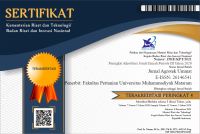Study of fortification of red dragon (Hylocereus polyrhizus) meat and skin on microbiological and organoleptic quality white sticky rice tapai
Abstract
White glutinous tapai is a fermented food product in which yeast is added in manufacturing. Red dragon fruit can be added to increase the nutritional value, taste and product diversification of processed white sticky rice tapai. Besides being rich in nutritional value, red dragon fruit also contains antioxidant compounds, natural food fiber and natural colouring compounds that display a purplish-red colour. This study aims to determine the effect of fortification of red dragon fruit meat and skin on fiber content and organoleptic quality of white sticky rice. This study was experimental, using a completely randomized design (CRD), with the fortification of red dragon fruit meat and skin in the production of white sticky rice tapai. The type of treatment: T1 = white glutinous rice without red dragon fruit (control), T2 = white glutinous rice + red dragon fruit pulp, T3 = white glutinous rice + (flesh and skin) of red dragon fruit, and T4 = white glutinous rice + red dragon fruit skin). Observational data were analyzed by analysis of variance (ANOVA) at a 5% significance level and follow-up test with HSD at the same significant level. The results of the analysis of the quantity of microorganisms in white sticky rice tapai yeast with fortification treatment of red dragon fruit flesh and skin showed that the sticky rice tapai contained 2.9x104 microbes in T1, 6.0x104 in T2, 7.1x104 in T3 and 4.0x104 in T4 and research results organoleptic properties of the colour, aroma, taste and texture score parameters. The best treatment preferred by the panellists was the T2 treatment (fortification of red dragon fruit pulp) with a fiber content of 4.13%, a pH value of 5.13, an aroma value score of 3.39 (slightly tapai flavour), a taste of 4.11 (liked it), texture 3.29 (slightly soft) with a purplish red appearance 3.86. The use of a mixture of dragon fruit, dragon fruit skin is able to produce the most suitable organoleptic assessment for white sticky rice compared to the use of dragon fruit skin from the results of organoleptic panelists and statistical tests. The use of dragon fruit in producing aroma, taste, and homogeneity are more preferred, while other parameters of color tend not to be affected. Total microbes, log 4.85, were the highest produced by fortification using dragon fruit skin. The use of dragon fruit flesh, which causes the sour taste is not strong and good color other treatments to be more acceptable to panelists.
Keywords
Full Text:
PDF (Bahasa Indonesia)References
Adhayanti, I., & Ahmad, T. (2021). Kadar Vitamin C dan Aktivitas Antioksidan Kulit Buah Naga Segar (Hylocereus S). Media Farmasi, 17(2), 157. https://doi.org/10.32382/mf.v17i2.2273
Agustina, M., Soegianto, L., & Sinansari, R. (2021). Uji Aktivitas Antibakteri Hasil Fermentasi Kulit Buah Naga Merah (Hylocereus polyrhizus) terhadap Propionibacterium acnes. Jurnal Farmasi Sains Dan Terapan, 8(1), 1–7. Retrieved from http://journal.wima.ac.id/index.php/JFST/article/view/3086
Anasa, R. A., Nurlaila, W., Dharmastuti, W., Santoso, I., Maryanto, A. E., Sitaresmi, S., & Yasman, Y. (2019). Isolation and screening of amylase activity of primary moulds in Ragi Tapai of Indonesia. AIP Conference Proceedings, 2168. https://doi.org/10.1063/1.5132507
Aryanta, I. W. R. (2022). Manfaat Buah Naga Untuk Kesehatan. Widya Kesehatan, 4(2), 8–13. https://doi.org/10.32795/widyakesehatan.v4i2.3386
Ayun, Q., Khomsiyah, & Ajeng, A. (2022). PENGARUH pH LARUTAN TERHADAP KESTABILAN WARNA SENYAWA ANTOSIANIN YANG TERDAPAT PADA EKSTRAK KULIT BUAH NAGA (Hylocereus costaricensis). Jurnal Crystal : Publikasi Penelitian Kimia Dan Terapannya, 4(1), 1–6. https://doi.org/10.36526/jc.v4i1.2090
Eko Wiyono, A., Windaru Runteka, O., Choiron, M., Ruriani, E., & Belgis, M. (2022). STABILITAS SERBUK PEWARNA ALAMI BERBASIS ANTOSIANIN BUAH NAGA MERAH APKIR TERVARIASI PELARUT ASAM DALAM BERBAGAI KONDISI EKSTERNA. Jurnal Agritechno, 74–84. https://doi.org/10.20956/at.vi.693
Hana Nita Isnaini, Adi Saputrayadi, D. A. S. (2022). Mutu Tapai Beras Ketan Putih Dengan Penambahan Buah Naga Sebagai Warna Alami. Braz Dent J., 33(1), 1–12.
Harivaindaran, K. V., Rebecca, O. P. S., & Chandran, S. (2008). Study of optimal temperature, pH and stability of dragon fruit (Hylocereus polyrhizus) peel for use as potential natural colorant. Pakistan Journal of Biological Sciences, 11(18), 2259–2263. https://doi.org/10.3923/pjbs.2008.2259.2263
Indrasti, D., Andarwulan, N., … Wulandari, N. (2019). Suji Leaf Chlorophyll: Potential and Challenges as Natural Colorant. Jurnal Ilmu Pertanian Indonesia, 24(2), 109–116. https://doi.org/10.18343/jipi.24.2.109
Inelvi, Y. (2018). Seleksi dan Potensi Mikroba Amilolitik Beberapa Ragi Tapai Lokal Sumatera Barat Dalam Konversi Pati Ubi Kayu Menjadi Gula.
Lubis, M. S., Rafita Yuniarti, & Ariandi. (2020). PEMANFAATAN PEWARNA ALAMI KULIT BUAH NAGA MERAH SERTA APLIKASINYA PADA MAKANAN. AMALIAH: JURNAL PENGABDIAN KEPADA MASYARAKAT, 4(2), 110–114. https://doi.org/10.32696/ajpkm.v4i2.512
Meganingtyas, W., & Alauhdin, M. (2021). Ekstraksi Antosianin dari Kulit Buah Naga (Hylocereus costaricensis) dan Pemanfaatannya sebagai Indikator Alami Titrasi Asam-Basa. agriTECH, 41(3), 278. https://doi.org/10.22146/agritech.52197
Surbakti, F. (2021). IDENTIFIKASI DAN KARAKTERISASI BAKTERI ASAM LAKTAT PADA ACAR KETIMUN (Cucumis sativus L.) SEBAGAI AGENSI PROBIOTIK. Jurnal Teknologi Pangan Dan Kesehatan (The Journal of Food Technology and Health), 1(1), 31–37. https://doi.org/10.36441/jtepakes.v1i1.182
Sutanto, T. D., & Hp., A. M. (2006). Studi Kandungan Etanol Dalam Tapai Hasil Fermentasi Beras Ketan Hitam Dan Putih. Jurnal Gradien, 2(1), 123–125.
ul-Haque, D. S. N. S. M., & Mueedin, N. (2021). Fermentation of Tapai and Alcohol Content Released From Tapai. IOP Conference Series: Materials Science and Engineering, 1053(1), 012050. https://doi.org/10.1088/1757-899x/1053/1/012050
DOI: https://doi.org/10.31764/jau.v11i2.22816
Refbacks
- There are currently no refbacks.
Copyright (c) 2024 Sari, Asmawati Asmawati, & Saputrayadi

This work is licensed under a Creative Commons Attribution-ShareAlike 4.0 International License.

 |  |  |  |
| |||
 |  |  |
|
Alamat Kantor












